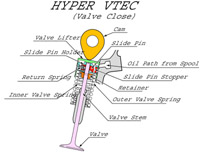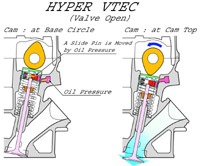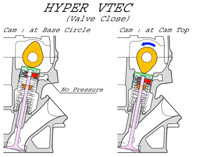Honda’s 2002 VFR 800 is much changed from the highly acclaimed 2000/2001 model that we tested some time ago.
The new 2-stage valve control system, called ‘V4 VTEC’, is chain driven and aims to provide more torque through the lower and middle ranges by only utilising two valves in each cylinder until just over 7,000 rpm when the other two valves per cylinder also kick in to play. The bike responds with a distinct change in engine note and intake roar as all four valves come on song. Lower down in the rev ranges my seat of the pants felt only the slightest of improvements over the earlier non ‘VTEC’ model, but power seems a little stronger up top than before with a generous amount of over-rev.
The new engine is noticeably quieter than the previous model. Gone is the characteristic whine from the gear driven cams in the 781cc V-Four engine. This is mainly due to the move to chain drive for the cams but also the reduction in noise from only having two valves per cylinder operating most of the time rather than four. The ultra smooth six-speed gearbox complements the sophisticated fuel-injected engine and the two work seamlessly together to provide reasonably strong drive at any road speed.
The gearbox ratios have also been changed. First, second and third gears are now closer together and combine with a one-tooth smaller front sprocket to deliver sharper acceleration. To reduce the shocks of upshifts to the drive train the clutch’s 2-step coil spring damper was replaced with a new 3-step damper that ensures smoother, more comfortable operation in virtually all traffic and riding conditions.
The new VTEC system features a set of compact, hydraulically actuated lifter sleeves installed inside the inverted buckets of the valve train’s direct-actuation valve lifters, over one intake valve and one exhaust valve in each cylinder. During low-to-midrange operation, the lifter sleeves slide benignly up and down over the tops of the valve stems, allowing only two valves in each cylinder to open.
At around 7,000 rpm a burst of oil pressure to the lifter sleeves forces their spring-loaded engagement pins to slide across the centre hole and initiate actuation of the remaining two valves of each cylinder. The engine suddenly comes on cam, full 4-valve operation kicks in. The transition is remarkably smooth but it still can be felt and a little care is needed on very slippery surfaces.



The VFR’s excellent PGM-FI fuel injection system has also been upgraded with a set of new 12-hole injectors replacing the one-hole injectors currently used to realise finer fuel atomisation. Combustion efficiency is also aided by new, hot-firing iridium spark plugs, which are ignited by compact, new, high-energy ‘coil-on-plug’ spark plug caps (like those used on the CBR600).
I owned a pre ‘VTEC’ VFR 800 for a while and enjoyed over 20,000 kilometres on the model. When on a bike tour a couple of years ago I also covered around 4,500 kilometres on the earlier 750 model. The first generation 800 progressed more over to the role of dedicated tourer than the early 750 but this latest ‘VTEC’ 800 seems to have regained some more of the VFR’s original sporting intentions.
Not so much from the drivetrain but from the fact that the bike seems more up to being ridden a little harder than before. The suspension is soft and supple to iron out all the road irregularities and too soft for serious track day use but is more than capable of being hustled quite quickly when enjoying a set of bends on the street. It is easily up to the task of any fast road work and I have no doubt a good rider on a VFR will always have the upper hand when pitted against a less experienced rider on the latest crotch rocket.
The frame has a revised steering head and larger 43mm stanchion tubes in place of the earlier model’s 41mm tubes with revised valving which explains some of the performance improvement.
Braking performance is exceptional. This latest generation combined braking system is by far the best yet seen and is perfectly suited for road work, yes even for fast road work. At the track I would still prefer independent brakes but the track is not what the VFR is about. The touring biased suspension would be the limiting factor at the track, not the combined brakes. I tested the VFR back-to-back with a CBR 929 in full emergency stop tests from 100kph down to a complete halt. To my amazement the VFR managed to pull up a few feet shorter than the Fireblade on every occasion, even when swapping riders and performing the test time after time. I would still prefer the Fireblade brakes for racetrack duties but there is no question that the VFR has some of the best road speed braking performance available.
Some markets also get the option of ABS. Australia receives only the non-ABS model. So instead of having a DCBS-ABS we just get the DCBS.
Where nearly all previous Dual Combined Brake Systems use the front brake lever to control the two outer pistons of both front 3-piston calipers, the new VFR’s front brake lever operates the two outer pistons of the left-side front caliper and all three pistons of the right-side caliper, as well as the centre piston of the rear brake caliper (by way of the secondary master cylinder), resulting in a more front-oriented braking response.
The foot brake pedal that previously actuated the two outer pistons of the rear brake caliper and both centre pistons of the front calipers now actuates the same two rear brake caliper pistons, but only the one centre piston of the left front caliper. This revised balance of braking force is administered through a direct-side proportional control valve (PCV) mounted inline between the foot brake master cylinder and the rear caliper.
During light applications of the foot brake, most of the actual braking force is applied at the rear wheel, with only the slightest amount of front brake input at the one left-side caliper providing a steadying influence on the balance of front and rear brake control without causing unsettling shifts of weight and its related front-end dive.
However, this balance of operation changes in response to strong pedal operation, in which case the system adjusts for an optimal balance of front and rear braking forces.
As in other Dual Combined Brake Systems, the compact secondary master cylinder integrated into the left-side caliper’s pivoting mount increases rear caliper brake pressure through a servo-side PCV as its own braking forces increase in response to front brake lever actuation. This results in a smooth combined force that starts with greater emphasis on the front brakes and gradually, but firmly, applies a balancing amount of rear brake whenever the situation calls for it.
Taken together, these two brake operation scenarios provide a more aggressive distribution of braking forces that both enhances braking confidence for a wider range of riders and skill levels. Put simply, these brakes are excellent.
Comfort was high on the list of design parameters for the VFR and it must be said that the VFR is about as comfortable as motorcycles get. Even the pillion passenger is well looked after with reasonable leg room and generous seat padding. Wind and weather protection is of course excellent.
The VFR’s newly designed instrument panel provides a centrally positioned rev counter and two large LCD readouts which show speed, tripmeters, fuel gauge and a clock. LED indicators also provide instant notification of ABS and H.I.S.S. operations, as well as the standard array of functions. Engine temp is also displayed and can be switched to show outside air temp’ at the press of a button.
Honda claim the fuel tank is designed to make it more suitable for a tankbag. I disagree, my tankbag fitted much more securely on both the Fireblade and CBR 600. One plus for the new bike though is the fact that much less wind buffeting results from having a tankbag fitted than on the previous 800. On the last model a tankbag really seemed to disturb the airflow behind the screen which resulted in some pretty bad turbulence at times.
Another point that the new tank does have in it’s favour though is an increase in fuel capacity from 21 to 22 litres. That doesn’t sound much but it does translate to around 20 kilometres in distance which is nothing to sneeze at. The touring range of the new VFR equates to around 300 kilometres during average riding. In excess of 400 kilometres could be achieved at strictly legal speeds.
Honda’s latest anti-theft system features a fail-safe electronic interlock that prevents the engine from being started by any other than the motorcycle’s two original keys. Since H.I.S.S. disables the motorcycle at the heart of its ignition system, it cannot be bypassed by either hot-wiring the ignition or exchanging the ignition switch module. This is great to see, all motorcycles should have a similar sort of system. In this day and age there is no excuse not to. I also see no reason why this type of security should be restricted to road bikes. Considering the amazing rate of dirt bike theft we suffer in Australia the sooner manufacturers start providing proper security on their dirt range the better.
Sliding into place over the tail of the seat when not carrying a pillion is a colour matched seat cowl. Disappointing is the distinct lack of underseat storage space. I guess this is a result of having the mufflers tucked under the rear bodywork. However the positive side of having the mufflers under the tail is the fact that the fully integrated (optional) panniers can sit closer to the bike and the pillion scores 10mm extra leg room over the previous model. A 45 litre top box is also available, as is a taller screen.
Pillion grab handles are comfortable and well located. Another point worth mentioning is that they are level with the height of the pillion seat and make fine tie-down points and/or they can serve as a rack to mount things on when travelling solo, without the solo seat cowl in place of course.
The new ‘VTEC’ VFR is a highly accomplished machine. Most of the other bikes in this market segment offer a lot more cubes than the 781cc VFR but not many provide such a level of technical sophistication and polish. It has enough power to get by in any road based situation but does lack that real bottom end grunt that some of the bigger bikes possess. However the engine/gearbox combination fitted to the VFR is the most refined, dare I say classy, package I have ever sampled.
Previous VFR fans will not be disappointed in this improved new model, and nor should they be. If you can only afford one vehicle to do everything then the VFR is still one of the smartest choices around. Or if you already have a full tilt sportsbike and are considering a second bike for touring duties, with or without a pillion, the VFR deserves serious consideration.
Specifications
Bore X Stroke ≈ 72 X 48mm
Displacement ≈ 781.7cm3
Compression Ratio ≈ 11.6 : 1
Fuel Supply ≈ PGM-FI electronic fuel injection
Max. Power Output ≈ 107hp @ 10,500min
Max. Torque ≈ 80Nm @ 8,750min
Ignition ≈ Computer-controlled digital transistorized with electronic advance
Starter ≈ Electric
Transmission ≈ 6-speed
Final Drive ≈ ‘O’-ring sealed chain
Dimensions ≈ (LxWxH) 2,120 X 735 X 1,195mm
Wheelbase ≈ 1,460mm
Seat Height ≈ 805mm
Ground Clearance≈ 130mm
Fuel Capacity ≈ 22 litres
Rims ≈ 17 X 3.50 ‘U’-section 6-spoke cast aluminium (Front) – 17 X 5.50 5-spoke cast aluminium
Tyres ≈ 120/70 ZR 17 (Front) – 180/55 ZR17 (Rear)
Front Suspension ≈ 43mm H.M.A.S. cartridge-type telescopic fork with stepless preload adjustment, 109mm axle travel
Rear Suspension ≈ Pro-Link with gas-charged H.M.A.S. damper, 7-step preload and stepless rebound damping adjustment, 120mm axle travel
Front Brakes ≈296 X 4.5mm dual floating hydraulic disc with Combined 3-piston calipers and sintered metal pads
Rear Brakes ≈256 X 6mm hydraulic disc with Combined 3-piston caliper and sintered metal pads
Dry Weight ≈ 213kg
RRP ≈ $17,490 + ORC
Engine ≈ Liquid-cooled 4-stroke 16-valve DOHC 90º V-4























